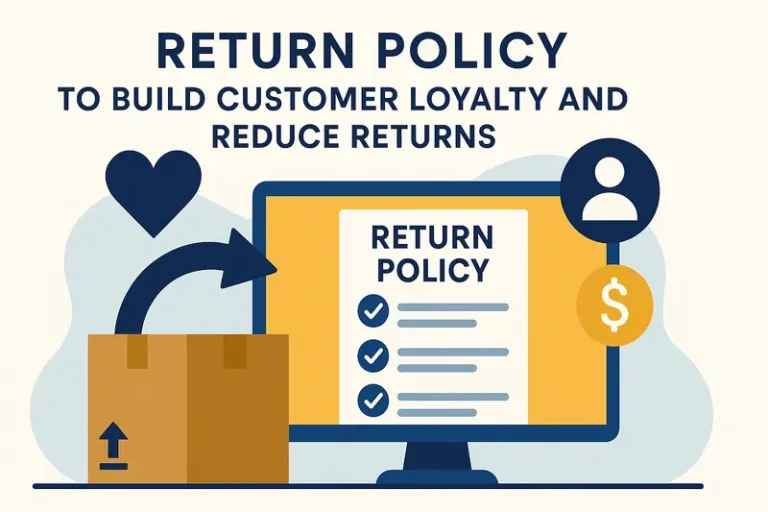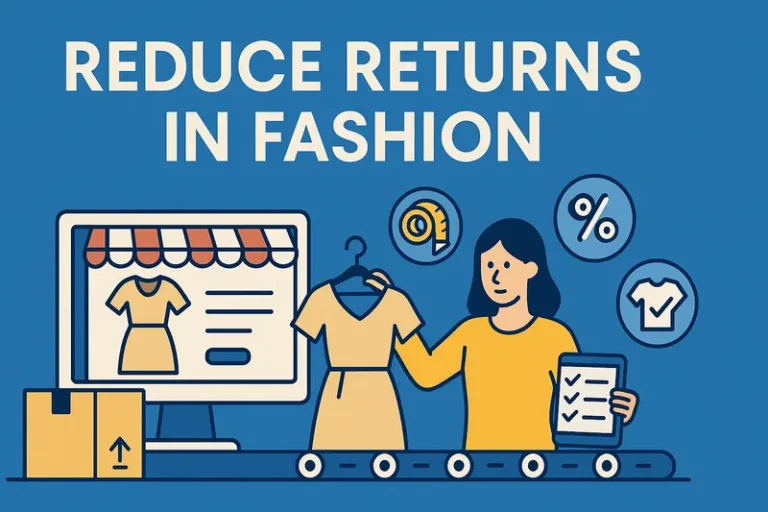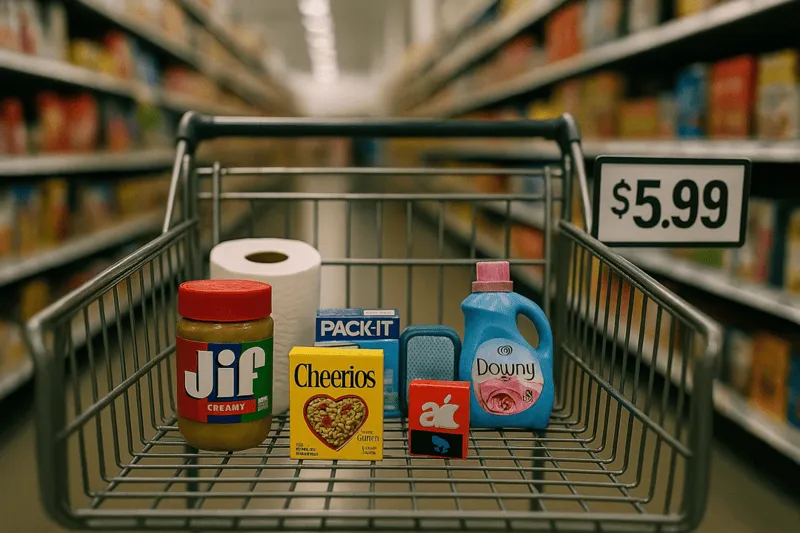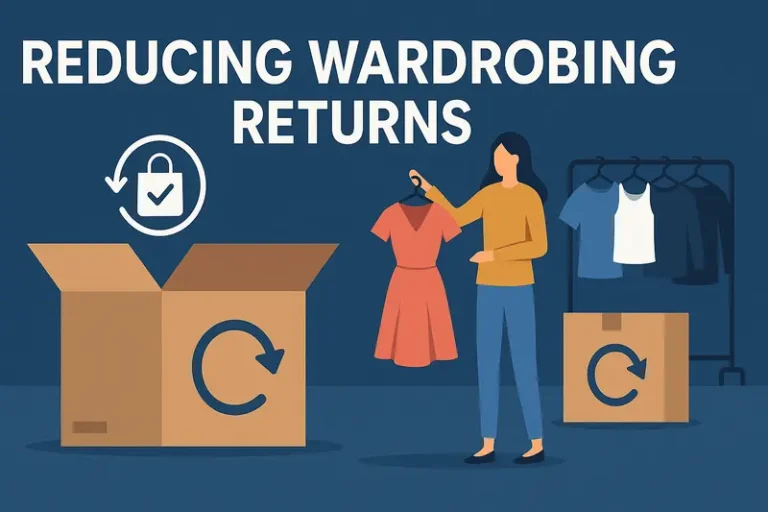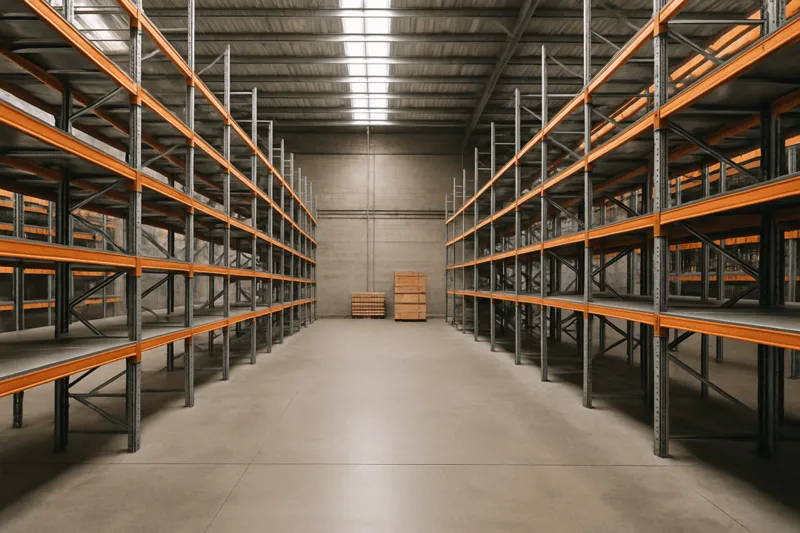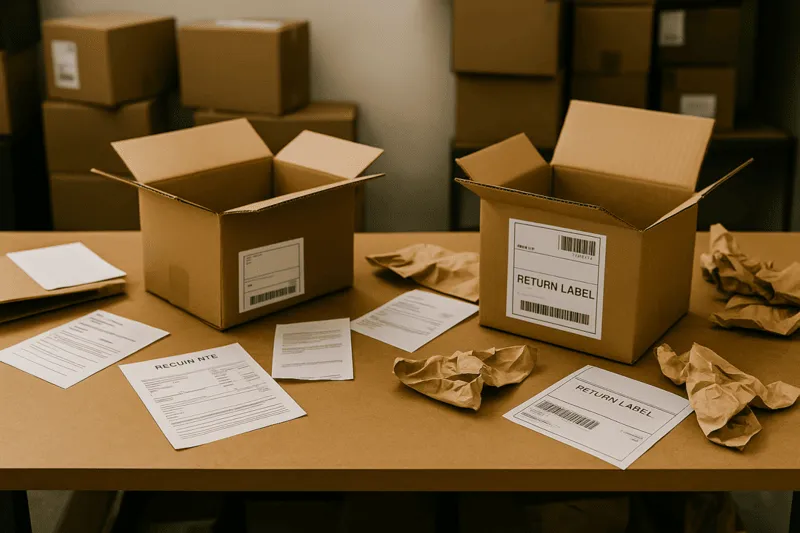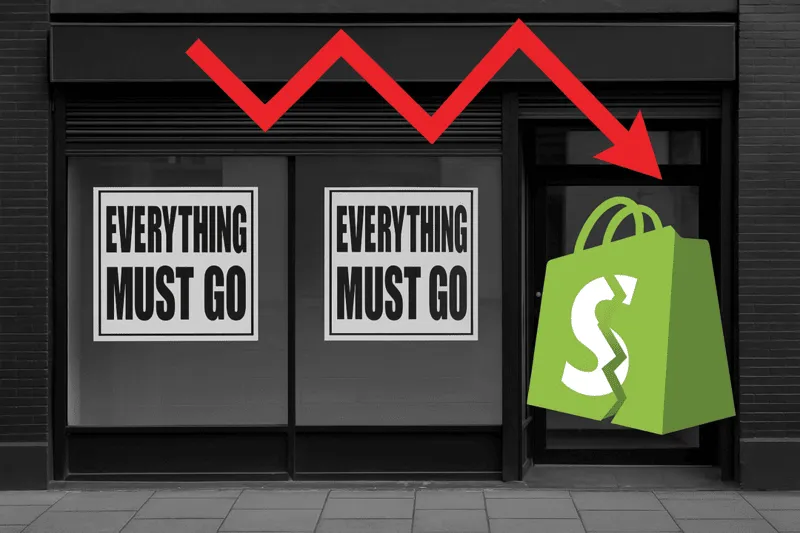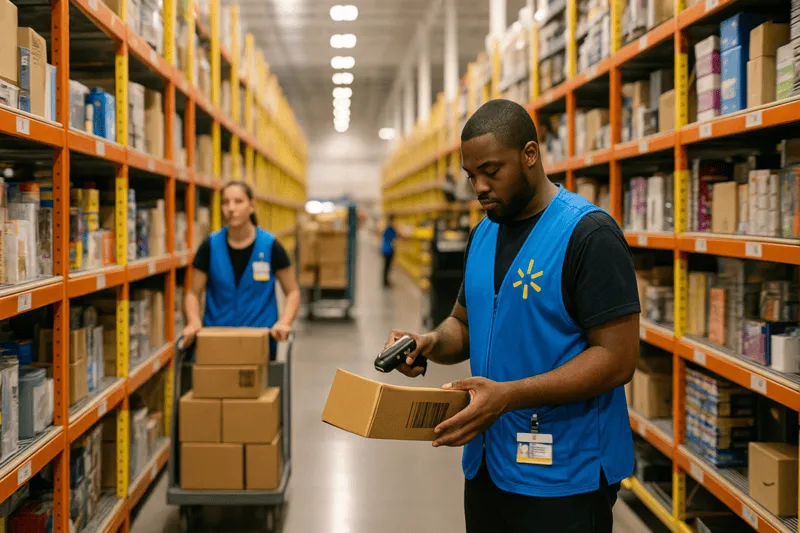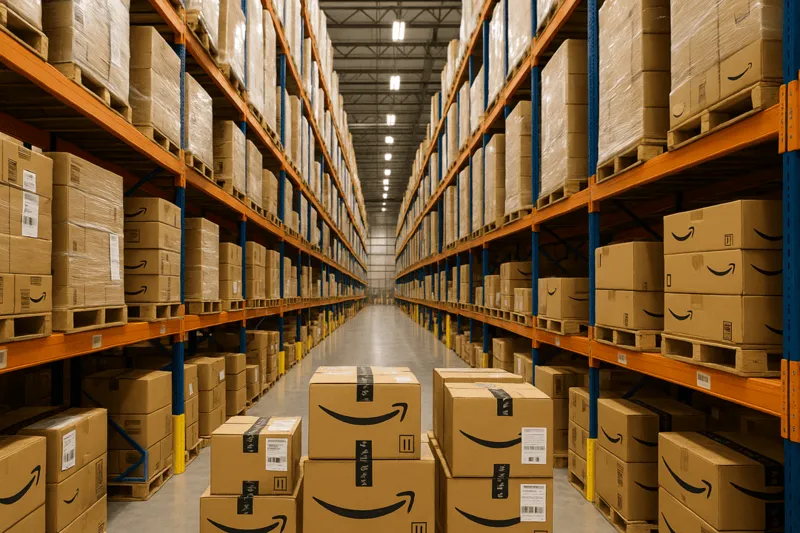What Is Dunnage: Types, Uses, and Benefits
In this article
 13 minutes
13 minutes
- Key Takeaways
- Defining Dunnage
- Types of Dunnage Materials
- Benefits of Using Dunnage
- Choosing the Right Dunnage
- Regulatory Compliance & Safety Standards
- Reusable Dunnage Options
- Improving Shipping Efficiency with Dunnage
- Tracking Dunnage Inventory
- Cost-Effective Dunnage Strategies
- The Future of Dunnage in Logistics
- Summary
- Frequently Asked Questions
Dunnage refers to materials used to protect goods during shipping by filling empty spaces and preventing movement. In this article, we will explore what dunnage is, as well as various types such as bubble wrap, wood, and foam, their uses, and the benefits of using dunnage for safe transportation.
Key Takeaways
- Dunnage is essential for protecting goods during shipping, preventing damage by filling voids and absorbing shocks.
- There are various types of dunnage materials, including bubble wrap, wood, and air pillows, each suited for different shipping needs.
- Investing in proper dunnage not only minimizes damages and returns but can also improve shipping efficiency and compliance with regulations.
Defining Dunnage
Dunnage refers to any robust material utilized in shipping. It serves to safeguard goods from damage. Its primary role is to fill empty spaces within packaging, preventing items from shifting and sustaining damage during transport. This can include anything from preventing scratches and dents to absorbing shocks and vibrations that occur during transit. Choosing the correct amount of dunnage helps businesses significantly reduce returns caused by damages, ensuring products arrive in perfect condition.
Dunnage is not just about protecting individual products; it also plays a crucial role in the overall safety and efficiency of shipping operations. Proper dunnage and steel dunnage ensure the well-being of individuals handling the shipments and maintain the integrity of the cargo protection, including crisscrossed dunnage and floor dunnage.
Whether you’re shipping fragile items that require more material or heavy goods that need structural support, understanding the various types of dunnage materials and fragile materials available can help you make informed decisions.
Slash Your Fulfillment Costs by Up to 30%
Cut shipping expenses by 30% and boost profit with Cahoot's AI-optimized fulfillment services and modern tech —no overheads and no humans required!
I'm Interested in Saving Time and MoneyTypes of Dunnage Materials
Dunnage materials come in various forms, each with unique characteristics suited for specific shipping needs. Common dunnage materials include:
- Bubble wrap
- Solid plastics
- Air pillows
- Wood
- Foam
- Paper-based materials
Knowing these materials helps in selecting the appropriate type of dunnage, providing optimal protection and efficiency during transit.
Bubble Wrap
Still one of the most common forms of protective dunnage, bubble wrap is a versatile packing material primarily used for shock absorption, making it ideal for protecting fragile items like glass and ceramics during shipping. It’s great for wrapping individual items, though traditional bubble wrap can generate static, so avoid it for electronics. Its popularity stems from its reliability and durability; however, it is not biodegradable, and burst bubbles can lose their protective ability over long hauls.
Even with these drawbacks, bubble wrap continues to be a preferred choice for many shippers because of its effectiveness in filling packaging gaps and protecting delicate items.
Solid Plastics
Solid plastic dunnage, often made from high-density polyethylene, is used for high-value industrial shipping due to its robustness and durability. This type of dunnage is particularly effective for protecting heavy and expensive items such as electronics, glass, and ceramics. Its moisture-blocking capabilities and ability to absorb spills further enhance its protective qualities.
Although solid plastics can be pricier, their durability makes them a valuable investment for high-value shipments.
Air Pillows
Air pillows are lightweight, air-filled plastic bags that:
- Provide cushioning and protection during shipping
- Serve as an efficient gap filler (especially in relatively snug boxes)
- Keep items stationary
- Absorb shocks during transport
Air pillows provide a cheap and reusable packaging solution, though they can lose effectiveness if they pop during transit. Their lightweight nature and low cost still make them popular for less fragile items, but they collapse under pressure, so don’t use them for heavy or sharp objects.
Wood Dunnage
Wood dunnage is commonly used for transporting large machinery and appliances. It is also suitable for electronics. It serves as a barrier between heavy goods, preventing damage and stabilizing items within shipping containers. Wooden pallets, considered a form of wood dunnage, provide a sturdy base for large, heavy products like construction materials. Wood is an affordable and ethically sourced material, making it a sustainable choice for dunnage.
For international shipments, wood must be heat-treated and stamped to meet ISPM-15 compliance, ensuring it is free from pests and contaminants.
Despite the need for treatment, wood’s reusability and structural integrity make it a reliable choice for heavy-duty dunnage applications.
Foam Dunnage

When you’re shipping fragile or high-value items, foam is your best friend. Foam dunnage is ideal for protecting delicate items such as electronics, glassware, and medical equipment during transit. Die-cut foam inserts prevent movement, absorb shock, and give off a high-end feel. It comes in two primary types: open-cell foam, which is excellent for cushioning, and closed-cell foam, which offers better moisture and chemical resistance.
Although foam dunnage can be recycled and reused, it is generally less eco-friendly compared to materials like kraft paper. Its lightweight and customizable nature still makes it suitable for various applications.
Molded Pulp or Paper Pulp Inserts
These are becoming increasingly popular as a sustainable alternative to foam. They’re sturdy, biodegradable, and great for consistent SKUs (e.g. candles, skincare jars).
Anti-Static Dunnage for Electronics
If you’re shipping semiconductors, electronics, or components, this is non-negotiable, as it prevents electrostatic discharge (ESD) damage during transport. Often made from foam or plastic treated with anti-static agents, this specialized dunnage ensures that sensitive electronic components remain safe from static electricity, which can cause significant damage if not properly managed.
Paper-Based Dunnage Materials
Paper-based dunnage, made from kraft or recycled paper, is the workhorse of eco-conscious brands. It’s versatile and recyclable, making it an eco-friendly and cost-effective cushioning material designed to fill voids in shipping boxes. Bonus: it makes unboxing feel more natural and “premium” for certain audiences.
Kraft paper is known for its strong tear resistance and cushioning capabilities, making it a popular choice for many shippers. Corrugated paper offers exceptional strength for heavy items while maintaining eco-friendly properties, addressing the growing customer demand for sustainable packaging solutions. It’s ideal for multi-unit shipments or bundled SKUs, as it prevents items from bumping into each other, and can be custom-fitted to boxes for maximum efficiency.
This type of dunnage is biodegradable and recyclable, making it a more sustainable option compared to plastic dunnage. Additionally, paper dunnage often costs less than plastic alternatives while providing comparable protection. Shredded paper, cardboard, or fill, is another paper-based option, serving as a recyclable alternative to packing peanuts and offering effective cushioning for lightweight products. Often used in boutique and gifting brands, it creates a luxurious feel, supports oddly shaped items, and keeps products stable. But beware: it can be messy and increase packaging time.
Custom Dunnage Solutions
Custom dunnage is key for shipping fragile or irregularly shaped items needing specific packaging dimensions. These tailored solutions protect valuable products by providing a perfect fit, ensuring better protection and stability during transit. Custom dunnage can be made from various materials, including foam, plastics, and metals, offering flexibility based on product needs.
Customization techniques, such as CNC cutting and molding, allow for the creation of dunnage that perfectly fits irregularly shaped products with very specific dimensions. Collaboration with dunnage providers can lead to uniquely tailored packaging solutions that enhance the protection of specific cargo.
While custom dunnage is often more expensive due to its bespoke nature, it is a worthwhile investment for businesses shipping high-value, fragile items.
Looking for a New 3PL? Start with this Free RFP Template
Cut weeks off your selection process. Avoid pitfalls. Get the only 3PL RFP checklist built for ecommerce brands, absolutely free.
Get My Free 3PL RFPBenefits of Using Dunnage
Dunnage materials play a critical role in securing shipments and keeping items stable during transportation, thereby minimizing the risk of movement that can lead to damage. Investing in proper dunnage helps businesses prevent costly replacements due to damaged goods, ensuring shipments arrive safely and intact.
The benefits of using dunnage include damage protection, moisture protection, and shock absorption, all of which contribute to the safe delivery of products.
Damage Protection
Dunnage plays a crucial role in absorbing shocks and vibrations, significantly reducing the risk of damage to goods. Proper use of dunnage can prevent fragile items such as delicate electronics and ornate glassware from being damaged during transport. Air pillows and dunnage bags are commonly used for filling voids and absorbing shock, ensuring the protection of sensitive items.
This not only enhances shipping safety but also minimizes shipping costs by reducing the likelihood of damage.
Moisture Protection
Moisture-resistant dunnage is essential for protecting products during transit, as moisture can cause significant damage. Certain dunnage types are designed to protect cargo from environmental factors, maintaining product integrity to protect goods.
For example, airbags not only protect against physical impacts but also help create barriers, maintaining moisture barriers and preventing damage from spills or humidity.
Shock Absorption
Effective dunnage materials, such as airbags and air pillows, provide excellent shock absorption properties, protecting delicate items during transit. Dunnage plays a crucial role in reducing the risk of damage caused by impacts during handling, ensuring that goods can absorb shock and be delivered safely and without damage.
Choosing the Right Dunnage
Selecting the right dunnage involves assessing the characteristics of the cargo, such as its fragility, weight, and shape. Businesses need to consider the types of products being shipped, the shipping methods used, and the specific packing options available. For example, wood is favored for its strength and versatility but may require additional protective measures for moisture-sensitive cargo. Custom dunnage solutions can be created to meet unique needs, ensuring enhanced protection and stability for specific cargo.
Regulatory compliance is also crucial when choosing dunnage, as various cargo types may have specific safety and legal requirements. Careful evaluation of these factors enables businesses to select the right dunnage materials, offering the best protection and regulatory compliance.
Regulatory Compliance & Safety Standards
Adhering to regulatory standards ensures the safe and legal transportation of goods. For example, ISPM-15 regulations require that wood dunnage used in international shipping be heat-treated and stamped to prevent the transfer of pests. Additionally, OSHA has specific load securement expectations that must be met to ensure the safety of cargo during transit.
Eco-label certifications can also play a significant role in demonstrating a commitment to sustainability. By adhering to these standards, businesses can ensure that their shipping practices are both safe and environmentally responsible.
Reusable Dunnage Options
Reusable dunnage options are not only environmentally sustainable but can also reduce long-term costs for businesses. Examples include:
- Wood dunnage, a renewable resource that can be reused multiple times.
- Foam dunnage, particularly types like expanded polypropylene (EPP), which is recyclable and supports eco-friendly packaging.
- Partnering with vendors who offer take-back programs or biodegradable materials to further enhance sustainability efforts.
Proper disposal or recycling of dunnage materials minimizes environmental impact. Implementing reuse practices and partnering with sustainable vendors helps businesses manage dunnage waste and packaging waste effectively, contributing to a greener shipping industry through the use of recycled materials.
Improving Shipping Efficiency with Dunnage
Dunnage streamlines the shipping process by optimizing shipping container space and reducing shipping costs. Materials like kraft paper and packing materials are cost-effective and ensure items arrive safely by minimizing in-transit movement. Air pillows provide cushioning for fragile items, further enhancing shipping efficiency. Businesses can also use dunnage to effectively ship products while maintaining safety.
Effective inventory management systems allow for real-time tracking of dunnage materials, ensuring their availability and location are continuously updated. Utilizing technology-driven solutions enhances decision-making in dunnage management by providing visibility into stock levels and usage patterns, ultimately improving overall shipping efficiency.
Tracking Dunnage Inventory
Tracking dunnage inventory is essential for maintaining adequate stock levels and avoiding supply shortages. An inventory management system allows businesses to monitor stock levels, usage rates, and reorder points, ensuring they have the necessary materials on hand when needed. Monitoring usage rates helps businesses understand how quickly dunnage is consumed, allowing for timely reorders.
Implementing best practices can enhance dunnage inventory management, including:
- Conducting regular audits
- Utilizing automated alerts
- Maintaining accurate records
- Setting reorder points based on usage rates
These practices allow businesses to effectively manage dunnage supplies and prevent waste.
Cost-Effective Dunnage Strategies
Cost-effective dunnage strategies balance quality and cost, allowing businesses to protect products during shipping without significantly raising overall shipping costs. Some cost-effective dunnage materials include kraft paper and corrugated paper, known for their protective qualities and affordability. Using lightweight dunnage materials can also reduce shipping expenses while still providing adequate protection.
To improve dunnage usage and shipping efficiency, consider the following strategies:
- Choose appropriately sized packaging for products to minimize dunnage waste and shipping costs.
- Utilize a digital logistics platform to optimize dunnage usage and enhance overall shipping efficiency.
- Maintain accurate records of dunnage inventory.
- Use data analytics to forecast future dunnage needs, allowing better planning and resource allocation to improve cost efficiency.
Scale Faster with the World’s First Peer-to-Peer Fulfillment Network
Tap into a nationwide network of high-performance partner warehouses — expand capacity, cut shipping costs, and reach customers 1–2 days faster.
Explore Fulfillment NetworkThe Future of Dunnage in Logistics
The future of dunnage in logistics lies in technology-driven optimization. AI-based dunnage optimization tools and 3D scanning for box size and void fill prediction are already transforming the industry. These technologies allow for more precise and efficient use of dunnage materials, reducing waste and improving protection for shipped goods.
Integrating dunnage planning into Warehouse Management Systems (WMS) or Transportation Management Systems (TMS) can further enhance shipping efficiency. As the shipping industry continues to evolve, the intelligent use of automation and optimization techniques will play a critical role in achieving faster fulfillment and reduced labor costs.
Summary
Understanding and utilizing the right dunnage materials is essential for ensuring the safe and efficient transportation of goods. From bubble wrap to custom solutions, each type of dunnage offers unique benefits and applications. By choosing the appropriate dunnage, businesses can protect their products from damage, moisture, and shocks, ultimately reducing costs and improving customer satisfaction.
As the logistics industry continues to innovate, the future of dunnage will be shaped by technological advancements and a growing emphasis on sustainability. By staying informed about the latest developments and best practices, businesses can optimize their shipping processes and contribute to a more sustainable and efficient future. So, make the smart choice, invest in proper dunnage, and watch your shipping operations thrive.
Frequently Asked Questions
What is dunnage?
Dunnage is the protective material used in shipping to fill empty spaces and prevent damage to goods by absorbing shocks and vibrations. It’s essential for keeping your items safe during transit!
What are some common types of dunnage materials?
You’ve got several options for dunnage materials, like bubble wrap, foam, wood, and air pillows. Each one helps protect your items during shipping and handling.
Why is regulatory compliance important for dunnage?
Regulatory compliance is important for dunnage because it guarantees the safe and legal transport of goods while meeting specific standards like ISPM-15 for wood materials. This not only protects your shipments but also helps avoid potential legal issues.
How can businesses track their dunnage inventory?
To effectively track dunnage inventory, businesses should utilize an inventory management system that keeps tabs on stock levels and usage rates. This way, they can always ensure they have the right materials available when needed.
What are the benefits of using reusable dunnage?
Using reusable dunnage is a smart choice because it’s environmentally friendly and can save your business money in the long run. Plus, with options like wood and foam dunnage, you’re supporting sustainability while cutting costs.

Turn Returns Into New Revenue
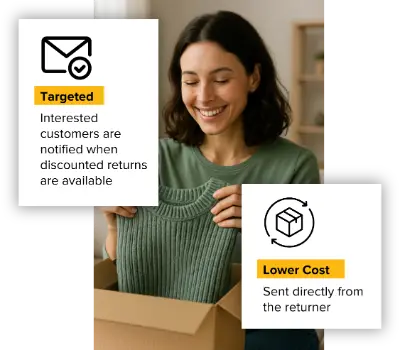
Shrinkflation Is Back: What Ecommerce Retailers Need to Know in 2025
In this article
 5 minutes
5 minutes
- What Is Shrinkflation (and When Did It Start)?
- Why Shrinkflation Isn’t Just About Product Size Anymore
- Why It’s Accelerating Now (And Who’s Leading It)
- Shrinking the Reverse Logistics Problem
- Should You Shrink Your Returns Policy?
- The Cahoot Take
- So What Should Brands Be Doing Right Now?
- Frequently Asked Questions
You know the feeling. You tear open your favorite snack bag, only to find it’s mostly air. You scroll Amazon for paper towels and realize the “12 = 24 rolls” trick isn’t fooling anyone anymore. That’s shrinkflation, where you’re paying the same, or more, for less.
But here’s the thing: Shrinkflation isn’t just a grocery store phenomenon. It’s creeping into ecommerce, DTC brands, and even the way retailers manage inventory, fulfillment, and returns.
So let’s unpack it. What is shrinkflation really doing to retail in 2025? And what’s your move if you’re running an ecommerce business?
What Is Shrinkflation (and When Did It Start)?
Shrinkflation has technically been around for decades. But it entered mainstream vocabulary during the post-pandemic inflation spike of 2021 – 2022, when CPG brands quietly started downsizing products without lowering prices.
Fast forward to 2025, and it’s become institutionalized. The Wall Street Journal recently reported that consumers now expect shrinkflation. It’s no longer a scandal, it’s a strategy.
What started with toilet paper and breakfast bars has extended to ecommerce packaging sizes, SKU quantities, return windows, and more.
Slash Your Fulfillment Costs by Up to 30%
Cut shipping expenses by 30% and boost profit with Cahoot's AI-optimized fulfillment services and modern tech —no overheads and no humans required!
I'm Interested in Saving Time and MoneyWhy Shrinkflation Isn’t Just About Product Size Anymore
Here’s where things get interesting. In ecommerce, shrinkflation shows up in ways that are harder to see, but just as costly:
- Bundles that include fewer items but still carry the same price tag.
- Return policies with stricter timelines and more exclusions.
- Free shipping thresholds are creeping upward, from $35 to $50, then $75.
- “Deluxe” editions that used to be standard, now basic, means barebones.
This is the kind of shrinkflation that impacts not just what consumers get, but what they expect from you as a brand. And it’s often hiding in plain sight.
Why It’s Accelerating Now (And Who’s Leading It)
In Q1 and Q2 of 2025, pressure on margins is back in a big way. Tariffs on Chinese imports, consumer pullback, and warehouse vacancies are making it tougher for ecommerce brands to survive, let alone grow.
So retailers are leaning into shrinkflation not as a one-time fix, but as part of a bigger playbook:
- Target quietly cut the size of its in-house tech accessories.
- A major DTC pet brand reduced its “starter kit” contents by 25%.
- A Shopify brand known for home goods reduced its return window from 60 to 30 days, citing “inventory health.”
They’re not advertising it. But if you read between the lines, or the reviews, you’ll spot the moves.
Shrinking the Reverse Logistics Problem
Here’s the twist nobody’s talking about: Shrinkflation isn’t just about getting more out of the sale. It’s also about cutting the cost of everything after the sale.
For example, returns.
In the past, brands could afford generous return policies because margins were fat. Not anymore.
Now we’re seeing:
- Fewer pre-paid return labels.
- More “final sale” language on seasonal SKUs.
- Higher restocking fees or “re-inspection” charges.
Returns are one of the biggest hidden costs in ecommerce, and shrinkflation is giving brands permission to quietly shrink that part of the business, too.
Looking for a New 3PL? Start with this Free RFP Template
Cut weeks off your selection process. Avoid pitfalls. Get the only 3PL RFP checklist built for ecommerce brands, absolutely free.
Get My Free 3PL RFPShould You Shrink Your Returns Policy?
Not automatically. If you’re building long-term customer trust, cutting corners on service can backfire.
But here’s what you should do: audit your reverse logistics. Ask questions like:
- Are we taking returns on items that can’t be resold profitably?
- Are our policies optimized for margin or for habit?
- Are there SKUs that should be final sale or non-returnable?
If the answer is yes, make strategic adjustments. Not punitive ones.
The Cahoot Take
At Cahoot, we’re seeing more brands experiment with leaner fulfillment and returns strategies, not by squeezing customers, but by gaining more control over how returns are routed, restocked, or resold.
For example, peer-to-peer returns allow brands to keep returned items circulating closer to the next buyer, avoiding restock delays and slashing return shipping costs. That’s not shrinkflation. That’s smart fulfillment.
Shrinkflation is inevitable. But how you manage it isn’t.
So What Should Brands Be Doing Right Now?
Well, you can’t completely avoid shrinkflation in today’s market. But you can be intentional about it.
Here’s what I’m telling brands:
- Be transparent where it counts. If you’re reducing bundle sizes, explain why.
- Audit returns before slashing them. Customer experience still matters.
- Get proactive with fulfillment efficiency before costs force your hand.
- Use this moment to clean up your SKU strategy, packaging waste, and shipping bloat.
And above all, don’t assume customers aren’t paying attention. They are, especially the ones you want to keep.
Frequently Asked Questions
What is shrinkflation in ecommerce?
Shrinkflation in ecommerce refers to the practice of reducing product quantity, features, or services while keeping prices the same or increasing them, often subtly, such as smaller bundles or stricter return policies.
How is shrinkflation affecting online retail in 2025?
Retailers are downsizing offerings, tightening returns, and raising shipping thresholds to protect margins amid tariffs, inflation, and slowed consumer spending.
Are consumers aware of shrinkflation?
Yes, consumer awareness is growing. Many are actively calling it out in reviews or social media, especially when changes feel deceptive or unacknowledged.
Is shrinkflation legal?
Yes, as long as the packaging and product info are accurate. However, misleading practices can risk reputational damage and consumer trust.
How can ecommerce brands manage shrinkflation without hurting loyalty?
Be transparent, audit returns strategically, and explore fulfillment models that cut costs without compromising the customer experience, like Cahoot’s peer-to-peer network.

Turn Returns Into New Revenue

How Can Shippers Use Rising Vacancies to Secure More Flexible, Cost-Effective Storage?
The U.S. warehouse market is shifting fast. Vacancy rates just hit 7.1% in Q2 2025, the highest level in over a decade. It’s a dramatic swing from the space-constrained chaos of just a few years ago, when pandemic-fueled demand sent shippers scrambling to lock in square footage at any price.
Today, those same warehouses are sitting partially empty. Sublease availability has surged past 225 million square feet, and developers have slashed new construction by 45% year-over-year. For brands and logistics teams still feeling whiplash from last year’s stockpiling wave, the current moment might look like a warning. But with the right strategy, it’s actually a window of opportunity.
The Hidden Cost of Empty Space
Leased square footage that sits idle is more than just a sunk cost; it’s a drag on cash flow, inventory turns, and operational efficiency. Many brands overcommitted during the supply chain panic and are now underutilizing expensive long-term leases. Rents, still averaging over $10 per square foot, haven’t dropped much due to lease lag. That means even as the market softens, the costs remain sticky.
If you’re a shipper sitting on more space than you need, it’s time to rethink your approach to storage. Subleasing is one option, but it isn’t always simple. Quality of sublease inventory can vary widely, and not every landlord is keen to play ball. That’s where more creative models are gaining traction.
Slash Your Fulfillment Costs by Up to 30%
Cut shipping expenses by 30% and boost profit with Cahoot's AI-optimized fulfillment services and modern tech —no overheads and no humans required!
I'm Interested in Saving Time and MoneyThe Rise of Flexible Storage Models
As traditional warehousing strains under cost and commitment, brands are exploring alternatives. Multi-tenant and shared warehouse spaces are becoming more viable for those with fluctuating demand. These environments allow shippers to expand or contract their footprint in real time, without the burden of long leases.
Another emerging option is the peer-to-peer fulfillment model. Platforms like the Cahoot P2P Fulfillment Network allow merchants to monetize their unused storage and fulfillment capacity by plugging into a distributed network of sellers. That means if you’re looking to get out of a lease, you might be able to repurpose your existing warehouse space as a revenue-generating node in someone else’s ecommerce operation. Or, if you’re winding down your lease entirely, you could still ship nationally using the Cahoot network without the overhead.
Negotiating From a Position of Strength
In softening warehouse markets like the Inland Empire, Dallas-Fort Worth, and even New Jersey, shippers are finding themselves in a rare buyer’s market. With construction down and sublease listings up, there’s leverage to negotiate short-term deals, flexible expansion clauses, and even tenant improvement credits, terms that would have been laughable in 2021.
But it takes planning. The key is to assess your demand cycles and real estate needs with brutal honesty. How much space do you truly need? Can your inventory strategy adapt to decentralized fulfillment? Would modular lease structures serve your business better than fixed commitments?
These are hard questions, but answering them now can create long-term resilience.
Timing the Real Estate Reset
Right now, we’re hearing from brands that are reevaluating every fixed cost on the books, and warehousing is near the top of the list. The companies that paused, audited their operations, and leaned into flexibility early are already seeing savings compound. One brand recently cut 40% of their storage expense by transitioning part of their fulfillment to Cahoot nodes; they didn’t lose autonomy, they gained agility.
That kind of agility is becoming a competitive advantage. It’s not just about finding cheaper storage, it’s about staying nimble when the market shifts again, and it will.
Looking for a New 3PL? Start with this Free RFP Template
Cut weeks off your selection process. Avoid pitfalls. Get the only 3PL RFP checklist built for ecommerce brands, absolutely free.
Get My Free 3PL RFPHow to Capitalize Now
This isn’t about gambling on the market. It’s about hedging against the next disruption while improving today’s bottom line. Whether that means subleasing, switching to a shared facility, or plugging into a P2P network, the goal is the same: reduce fixed costs, increase flexibility, and stay ready for whatever comes next.
The warehouse vacancy surge won’t last forever. But for shippers willing to act now, it’s a rare chance to shift from reactive leasing to a proactive strategy. Just make sure your space is working for you, not against you.
Frequently Asked Questions
What is driving the spike in warehouse vacancies in 2025?
The surge is largely due to pandemic-era overbuilding, reduced demand, and companies offloading excess space they acquired during the supply chain crunch of 2021–2023.
Why are rents still high despite rising vacancies?
Many leases were signed when the market was tight and are locked in for years. Landlords are not rushing to lower rates until those contracts come up for renewal.
What is a sublease, and is it worth considering?
A sublease is when a tenant leases out unused warehouse space to another company. It can be a cost-effective short-term option, but it requires due diligence on the space condition and lease terms.
What is peer-to-peer fulfillment?
Peer-to-peer fulfillment allows businesses to fulfill orders from each other’s warehouses using a shared technology platform like Cahoot. It’s a flexible and scalable alternative to owning or leasing large fulfillment centers.
How can smaller brands benefit from the warehouse vacancy trend?
Smaller brands can take advantage of shared warehouse spaces, short-term subleases, or P2P networks to avoid committing to expensive, long-term leases while maintaining nationwide shipping capabilities.

Turn Returns Into New Revenue

The Shipping Speed Paradox: Why DTC Brands Are Slowing Down
In this article
 5 minutes
5 minutes
Everyone’s talking about faster delivery. Amazon’s promising drone drops. Walmart’s turning stores into micro-fulfillment centers. And customer expectations? Sky high. But here’s the thing: most DTC brands aren’t speeding up, they’re tapping the brakes.
Sounds counterintuitive, right? But in 2025, slowing down might actually be the most strategic move you can make.
The Delivery Arms Race: Amazon and Walmart Go All-In
Let’s start with the big players. Amazon has spent the better part of a decade conditioning customers to expect one- or two-day delivery. In 2024, they doubled down again. More inventory was moved closer to end customers using their “regionalization” strategy, which chopped fulfillment distances in half. The result? According to Supply Chain Dive, 65% of Prime orders in Q2 2025 arrived the same day or the next day.
Walmart isn’t far behind. They’ve converted more than 4,500 stores into last-mile delivery hubs and are investing in AI-powered inventory placement. They’ve even launched parcel stations right inside their stores to boost local delivery capacity.
And yes, both are experimenting with drones. Amazon is testing lightweight drone delivery in a few southern U.S. zip codes. Walmart too. But let’s be honest: we’re still in science-project territory. Drone delivery may be flashy, but it’s barely scratching the surface of what really moves ecommerce.
Slash Your Fulfillment Costs by Up to 30%
Cut shipping expenses by 30% and boost profit with Cahoot's AI-optimized fulfillment services and modern tech —no overheads and no humans required!
I'm Interested in Saving Time and MoneyMeanwhile, DTC Brands Are Quietly Slowing Down
This part of the story isn’t getting enough airtime. While the retail giants race toward one-hour windows, thousands of independent ecommerce brands are stepping back.
Not because they want to disappoint customers, but because they can’t afford to keep up, and chasing Amazon’s logistics playbook is a losing game when you don’t have Amazon’s budget.
You know what I’m seeing? Brands freezing SKUs. Shrinking warehouse footprints. Letting go of that “2-day everywhere” promise. Not because they’re failing, but because they’re adapting.
And it’s not just a gut feel. According to July 2025 reports, Shopify store closures now outpace new installs. Many of those closures are logistics-related, brands crushed under the weight of expectations they could no longer afford to meet.
What Customers Actually Care About
Let’s cut through the noise.
A 2025 McKinsey study shows customers care about three things in this order:
- Free shipping
- Reliable delivery timelines
- Speed (same/next day)
Sustainability? It ranked dead last.
In fact, only 26% of shoppers said they’d pay even $1–2 extra for eco-friendly delivery. And when researchers tracked actual conversions? Fewer than 10% followed through. So while “green shipping” sounds great in a press release, it’s rarely what gets the sale.
Translation: customers expect fast and free. That’s a tough combo for DTC brands with thin margins.
The Hidden Costs of Chasing Speed
The faster you ship, the more you pay. You either:
- Store more inventory closer to the customer (higher storage and distribution costs), or
- Ship from a central location via air (higher parcel and carrier fees), or
- Overstaff fulfillment ops and erode margin at scale
Speed isn’t free, and when volume slows or inventory piles up, you’re left with expensive sunk costs.
We’re seeing the result now. DTC brands are caught in the “stockpile trap,” where inventory equals cash sitting on shelves. Remember, inventory isn’t just product; it’s tied-up working capital. If you can’t sell it fast enough to fund reorders, you’re stuck.
Looking for a New 3PL? Start with this Free RFP Template
Cut weeks off your selection process. Avoid pitfalls. Get the only 3PL RFP checklist built for ecommerce brands, absolutely free.
Get My Free 3PL RFPThe Drone Mirage
Let’s revisit the drones. They’re real. They’re operational in some pilot markets. But they’re limited to:
- Small packages under 5 pounds
- Favorable weather
- Specific delivery zones with limited obstructions
For the average brand selling apparel, home goods, or supplements, drones don’t meaningfully move the needle yet. And they won’t for most of 2025. If you’re betting your fulfillment future on drone scalability, you’re early. Way early.
Slowing Down on Purpose Is Not the Same as Falling Behind
When growth stalls, I don’t panic. I pause. I fix what’s broken, not what’s trending.
At Cahoot, we’re seeing smart brands slow down intentionally to:
- Vet new 3PLs or hybrid fulfillment solutions
- Reprice SKUs based on true landed cost
- Trim the fat from overbuilt operations
- Reallocate dollars from speed to retention
Slowing down doesn’t mean giving up. It means strengthening the core so you can scale sustainably when the market rebounds.
The Strategic Path Forward
Here’s the real takeaway: you don’t have to match Amazon or Walmart on delivery speed to win. You just have to meet your customers’ expectations and protect your margin while doing it.
Use 2025 to:
- Reaudit your shipping promises
- Simplify where needed
- Explore fulfillment partners that optimize speed and cost
- Make sure every dollar in ops contributes to LTV, not just CTR
Because speed is sexy, but resilience is what keeps you in the game.
Frequently Asked Questions
What is the “shipping speed paradox” in ecommerce?
It refers to the trend where retail giants are racing toward faster delivery, while many DTC brands are pulling back due to cost and sustainability constraints.
Are consumers really demanding same-day delivery?
Not necessarily. Most customers prioritize free shipping over speed. Same- or next-day delivery is nice to have, not a dealbreaker for most shoppers.
Why are DTC brands slowing down their delivery promises?
Because matching Amazon-level speed is expensive and often unsustainable for smaller brands without massive logistics infrastructure.
What’s the status of drone delivery for ecommerce brands in 2025?
Still very early. Amazon and Walmart are testing drone delivery, but it remains limited to small packages and specific markets.
How can DTC brands stay competitive without fast delivery?
By offering reliable shipping timelines, clear communication, and great post-purchase experiences. Fulfillment partners like Cahoot can also help streamline speed without killing margin.

Turn Returns Into New Revenue

Top 10 Ecommerce Returns Mistakes (and How to Fix Them)
In this article
 5 minutes
5 minutes
- 1. Not Having a Clear Return Policy
- 2. Offering Free Returns Without Doing the Math
- 3. Making the Return Process a Hassle
- 4. Treating Returns as a Cost Instead of a Signal
- 5. Not Reselling What You Could
- 6. Refunding Too Slowly
- 7. Not Offering Exchanges
- 8. Forcing Customers to Pay for Damaged or Defective Returns
- 9. Ignoring International Return Complexities
- 10. Treating Returns Like a Backroom Issue
- Final Thought
- Frequently Asked Questions
Returns are no longer just a post-sale nuisance, they’re a defining part of your customer experience, your margin, and frankly, your brand. Yet so many brands treat returns like a cost center to ignore until it bites them.
I’ve been deep in the ecommerce trenches long enough to know this: if you don’t actively manage returns, they will manage you. Let’s walk through the top 10 mistakes I see over and over, and what you should do differently before your profit margins take a nosedive.
1. Not Having a Clear Return Policy
If your return policy is vague, buried, or just plain confusing, you’re not just frustrating your customers; you’re setting yourself up for chargebacks, bad reviews, and support nightmares.
Fix: Spell it out. Be upfront about what’s returnable, how long customers have, and how they initiate a return. Make it easy to find (footer link, FAQ, order confirmation email) and easy to understand (no legalese, no fine print tricks).
2. Offering Free Returns Without Doing the Math
Yes, free returns boost conversion, but they can destroy margins if you’re not careful. Too many brands offer them without understanding their actual cost per order.
Fix: Run the numbers. Factor in shipping costs, restocking labor, product condition loss, and processing time. Then decide if free returns should be conditional (only for first-time orders, only for full-price items, etc.).
Make Returns Profitable, Yes!
Cut shipping and processing costs by 70% with our patented peer-to-peer returns solution. 4x faster than traditional returns.
See How It Works3. Making the Return Process a Hassle
Ever tried returning something and had to print three pages, repack it just right, and get to the post office before 4 pm on a Tuesday? Your customers hate that too.
Fix: Make it stupid easy. Include a prepaid return label or offer printerless returns with QR codes. Let customers initiate the return online without calling support. Track returns in the same dashboard as orders.
4. Treating Returns as a Cost Instead of a Signal
Returns are data. They tell you what’s broken, literally and figuratively, in your business—sizing problems, misleading descriptions, shipping damage, and quality issues. Most brands never read the return reasons, let alone analyze trends.
Fix: Create a monthly returns report. Track reasons by SKU, channel, and geography. Spot patterns. If one item has a 20% return rate, figure out why and fix it.
5. Not Reselling What You Could
Returned items that are perfectly good shouldn’t be collecting dust or ending up in landfills. If you’re trashing usable inventory, you’re leaving money on the table.
Fix: Set up a reverse logistics plan to restock, refurbish, or resell items via outlets, liquidation partners, or marketplaces like eBay. Every recovered dollar counts.
6. Refunding Too Slowly
Waiting 14 days after receiving a return to issue a refund might protect your cash flow, but it destroys trust. Customers start wondering if they’ve been ghosted.
Fix: Tighten up the refund cycle. Ideally, within 2–3 days of receipt. Automate confirmations and refund notices. Build goodwill by being proactive.
7. Not Offering Exchanges
Here’s the thing: Most customers returning something still want what you sell; they just want the right version of it. If you don’t offer easy exchanges, you’re turning potential revenue into refunds.
Fix: Enable smart exchanges. Let customers swap for different sizes or styles right in the return portal. Offer free exchanges even if returns aren’t free. Keep the sale.
8. Forcing Customers to Pay for Damaged or Defective Returns
This one’s brutal. Customer gets a busted item, reaches out, and you hit them with a return shipping fee? Say goodbye to that lifetime value.
Fix: Have a clear damaged/defective policy. Cover return shipping and offer replacements ASAP. Yes, it costs you in the short term, but it’s a small price for loyalty.
Convert Returns Into New Sales and Profits
Our peer-to-peer returns system instantly resells returned items—no warehouse processing, and get paid before you refund.
I'm Interested in Peer-to-Peer Returns9. Ignoring International Return Complexities
Cross-border returns are a whole different beast—duties, taxes, restocking in the wrong region—it gets expensive fast. Many brands just say “no international returns” and hope no one notices.
Fix: If you’re selling internationally, design a return flow that works. Use local carriers and consolidation partners. Consider refunding without return in some low-cost, high-friction cases.
10. Treating Returns Like a Backroom Issue
Returns shouldn’t be siloed to warehouse staff or an outsourced 3PL with zero feedback loops. If marketing, product, CX, and ops aren’t all looking at return trends, you’re missing out.
Fix: Returns are a team sport. Share data across departments. Let product know what breaks. Let CX see trends. Let marketing tweak messaging to reduce mismatch expectations.
Final Thought
Returns aren’t going away. In fact, they’re becoming more critical to your brand than ever. Nail the return experience and you’ll win more loyalty, reduce costs, and create the kind of customer-centric business that actually survives the shakeouts we’re seeing in 2025.
You don’t have to be perfect. But you do have to be intentional.
Frequently Asked Questions
What’s the biggest return mistake ecommerce brands make?
Not having a clear, easily accessible return policy that sets customer expectations.
How can I reduce the cost of free returns?
Limit them to certain SKUs, order types, or customers, and audit the return rates by product.
Should I allow exchanges instead of just refunds?
Yes, exchanges help preserve the sale and increase customer satisfaction.
How fast should refunds be processed?
Ideally, within 2–3 days of receiving the returned item.
What should I do with returned inventory?
If it’s resellable, restock or liquidate it through the right channels to recover margin.

Turn Returns Into New Revenue

Why the Tariff Pause Isn’t Free Money, And What Smart Brands Should Do Instead
So here we are: July 2025. Tariffs on China-made goods are sky-high, but the dust has temporarily settled. There’s a pause in new enforcement actions. And what’s the first thing a lot of brands are doing?
Stockpiling like it’s Costco on a snow day.
Look, I get the impulse. You want to beat future price hikes. Lock in rates now. Stay ahead of the next wave. But this mindset, that the tariff pause is some kind of bonus round or rebate window, is a dangerous trap. I’ve seen it play out, and it rarely ends well.
Why Brands Are Stockpiling (And Why That’s Risky)
Modern Retail recently highlighted how brands are tying up cash in inventory that might not sell for months. Some are maxing out warehouse capacity. Others are renting trailers just to hold product.
That’s not a strategy. That’s panic disguised as preparedness.
When you stockpile, you’re converting liquidity into risk. You’re betting on stable demand, perfect forecasting, and a logistics environment that won’t throw any curveballs. That’s a lot of assumptions.
And the math isn’t pretty:
- Holding costs are rising (storage fees, insurance, shrinkage).
- Demand is softening across DTC; June sales were down 25% YoY for small brands.
- Interest rates remain high, so capital is expensive.
Slash Your Fulfillment Costs by Up to 30%
Cut shipping expenses by 30% and boost profit with Cahoot's AI-optimized fulfillment services and modern tech —no overheads and no humans required!
I'm Interested in Saving Time and MoneyInventory Isn’t An Asset If It’s Not Moving
Let’s stop pretending every product sitting in a warehouse is “value.” If it’s not turning, it’s dead weight. And right now, many brands are sitting on SKUs that may not move until Q4, if at all.
Worse, some brands are prepaying for production to “lock in pricing,” leaving them vulnerable to shifts in demand, freight delays, or SKU obsolescence. Cash on shelf is not cash in hand.
I’ve personally seen brands take on more inventory than they could realistically sell in two quarters. And once your cash is tied up, options disappear. Marketing slows. Hiring freezes. And suddenly, you’re in survival mode, not growth mode.
What Smart Operators Are Doing Instead
The brands I see winning right now aren’t chasing bulk discounts; they’re chasing flexibility.
Here’s what they’re doing:
1. Hedging their sourcing
They’re not all-in on one supplier. They’re exploring Mexico, Vietnam, and even domestic production where feasible. Not because it’s cheaper (it’s often not), but because diversified sourcing creates leverage and optionality.
2. Rebalancing cash flow
Rather than drop $100K on inventory, they’re testing shorter runs. They’re working capital lines in smarter ways. And they’re getting surgical with demand planning, looking at return rates, sell-through velocity, and seasonality with fresh eyes.
3. Rethinking fulfillment
Tariffs are just one cost center. Fulfillment is another. Now’s the time to evaluate whether your fulfillment model is nimble. Can you scale up fast if demand spikes? Can you pull back quickly if it softens?
This is where Cahoot-style distributed fulfillment is a game-changer. You don’t have to commit to massive inventory deposits in one location. You flex regionally, based on demand, saving money on last-mile shipping and reducing your warehouse exposure.
The Trap Of Tariff-Driven Optimism
Every time there’s a pause, brands breathe a little easier. I get it. But temporary relief isn’t a long-term strategy. Tariffs could rise again. Port delays could return. Consumer sentiment could weaken further.
Smart founders are treating this moment like a chess move, not a victory lap. They’re asking:
- Where am I most exposed?
- Where am I overcommitted?
- How fast can I pivot if X happens?
If you can’t answer those questions confidently, you’re not in control, you’re just hoping the next hit doesn’t land.
Looking for a New 3PL? Start with this Free RFP Template
Cut weeks off your selection process. Avoid pitfalls. Get the only 3PL RFP checklist built for ecommerce brands, absolutely free.
Get My Free 3PL RFPFinal Thought: Play For Resilience, Not Rebates
This isn’t about being pessimistic. It’s about being ready.
There’s opportunity in this pause. But it won’t come from stockpiling; it’ll come from brands who treat the next 60 days as a strategic window. Tighten up ops. Diversify your sourcing. Build fulfillment agility.
Use the pause to prep your playbook, not to pile up product.
Frequently Asked Questions
What is the risk of stockpiling inventory during a tariff pause?
It ties up cash, increases holding costs, and exposes brands to shifts in demand or logistics disruptions.
How should brands respond to tariff uncertainty?
Diversify suppliers, test shorter production runs, and maintain fulfillment flexibility.
Is now a good time to invest in bulk production?
Only if demand forecasting is strong, otherwise, it’s safer to focus on agility.
How can a fulfillment strategy reduce tariff-related risk?
A flexible, distributed model like Cahoot helps reduce shipping costs and regional storage exposure.
Will tariffs increase again in 2025 and beyond?
It’s unclear, but most experts expect volatility; brands should plan accordingly.

Turn Returns Into New Revenue

Why Slowing Growth Could Be Your Secret Competitive Advantage
In this article
 4 minutes
4 minutes
- Growth Is Down? Good. Now Let’s Talk.
- The Pause Is Where The Magic Happens
- What Smart Brands Are Doing During The Slowdown
- Chasing Better Instead Of More
- Why Now Is The Best Time To Reinvent Your Ops
- What We’re Seeing At Cahoot
- Final Thought: Use The Slow Season To Outsmart, Not Outspend
- Frequently Asked Questions
Growth Is Down? Good. Now Let’s Talk.
This might sound strange coming from someone who spends their days helping ecommerce brands grow faster, ship smarter, and compete with giants. But here it is:
Slowing growth isn’t always bad. In fact, sometimes it’s exactly what your brand needs.
It forces you to pay attention to stuff you were too busy to look at before. Broken ops. Cost sinks. Sketchy suppliers. Shaky unit economics. When you’re growing at all costs, this stuff hides in the background. But when things slow down? It all surfaces.
Right now, according to AlixPartners, we’re seeing one of the sharpest ecommerce spending slowdowns in a decade. Consumers are pulling back. Tariffs are throwing sand in the gears. The Shopify Index shows more store closures than installs for the first time in years. And if you’re feeling the heat, you’re not alone.
But here’s the thing: this slowdown could be your wake-up call or your unfair advantage. Depending on what you do with it.
The Pause Is Where The Magic Happens
Every founder I know has sprinted through phases of insane growth where “we’ll fix that later” becomes a mantra. But later rarely comes. Until it’s forced on you.
That’s where we are now. A lot of brands are quietly hitting the wall. Not because their products are bad. But because their ops can’t keep up with their ambition.
So if growth has stalled for you, try asking:
What would I fix if I weren’t constantly chasing more?
Slash Your Fulfillment Costs by Up to 30%
Cut shipping expenses by 30% and boost profit with Cahoot's AI-optimized fulfillment services and modern tech —no overheads and no humans required!
I'm Interested in Saving Time and MoneyStart there.
What Smart Brands Are Doing During The Slowdown
Here are a few moves I’m seeing from operators who aren’t just waiting it out:
- Rebuilding their supplier network; offshoring was fine when margins were fat, but now nearshoring and dual sourcing are saving cash and reducing risk
- Auditing packaging, because oversized boxes are silent profit killers
- Rebalancing inventory with better forecasting tools, instead of stockpiling and hoping
- Training teams instead of just hiring faster, focusing on repeatability and clarity
- Experimenting with fulfillment models (Cahoot-style distributed shipping, hybrid 3PL + self-fulfillment setups, or even zone-skipping trials)
In short: they’re fixing the things they ignored while things were working “well enough.”
Chasing Better Instead Of More
There’s this quiet revolution happening among founders who are done with the growth-at-all-costs treadmill. They’re not giving up on scale, they’re just being smarter about it.
It reminds me of a conversation I had recently with a brand that pulled back from seven channels to three. Their sales dipped 12% for the quarter… but margins rose 18%, CSAT jumped, and their returns dropped by a third. Turns out, doing fewer things better pays.
They told me, “We stopped chasing ‘more’, and started chasing better.”
That stuck with me.
Why Now Is The Best Time To Reinvent Your Ops
Because no one else is.
Everyone else is panicking. Slashing budgets. Blaming ads. Praying Meta’s new algo will swing things around.
If you take this pause and use it to re-architect your backend, supply chain, fulfillment, customer experience, and inventory cadence, you will exit stronger. Period.
This is where you gain margin that compounds. This is where you discover operational leverage. And this is how you get ready for volume before it returns.
What We’re Seeing At Cahoot
Some of the smartest brands we work with are using this moment to finally clean up the mess:
- Testing Cahoot’s peer-to-peer fulfillment to reduce shipping zones and cost per package
- Auditing their warehouse placement to lower delivery time without overspending on storage
- Automating order routing and splitting to serve customers faster with less ops overhead
It’s not sexy, but it works. One brand cut its average shipping cost by 22% without changing carriers. Just smarter routing and storage.
Looking for a New 3PL? Start with this Free RFP Template
Cut weeks off your selection process. Avoid pitfalls. Get the only 3PL RFP checklist built for ecommerce brands, absolutely free.
Get My Free 3PL RFPFinal Thought: Use The Slow Season To Outsmart, Not Outspend
If growth has slowed, don’t just ride it out. Don’t just “make it through.”
Use it.
This is your shot to fix the stuff that matters. The stuff that makes growth sustainable, not scary. Because when things rebound, and they will, you’ll be ready. Faster, leaner, stronger.
Pause on purpose. The smart ones always do.
Frequently Asked Questions
What should I do if my ecommerce growth stalls?
Use the pause to fix operations, audit inventory, vet suppliers, and improve fulfillment.
Why is slowing down a good thing for DTC brands?
It creates space to optimize backend systems and improve margins.
How are brands responding to the ecommerce slowdown?
They’re rethinking their supply chains, experimenting with fulfillment, and improving forecasting.
Is this a temporary slump or a long-term shift?
It’s likely a correction, but smart brands treat it as an opportunity to get leaner and stronger.
Can Cahoot help during a growth slowdown?
Yes, by optimizing fulfillment and reducing shipping costs, Cahoot helps brands improve ops even when volume dips.

Turn Returns Into New Revenue

DTC Brands Are Dying Faster Than Ever
Ecommerce isn’t just cooling off; it’s contracting
In Q2 2025, Shopify store closures outpaced new installs for the first time ever: 1.5 closures per new store. That’s not a blip. That’s a reckoning.
Revenue for small DTC brands is down 25% year over year. The overall DTC market is down 9%. And consumer spending sentiment is the weakest it’s been since 2023. Just in April, 1% of DTC brands filed for Chapter 11. That’s a flood.
So what’s going on? Why now? And what can you actually do about it if you run a brand or support one?
The “Why” Behind the Collapse
Tariffs + Inventory = Cash Flow Crisis
Here’s the brutal math: tariffs go up; landed cost skyrockets. And a lot of brands placed orders ahead of the tariff hikes, only to watch demand dry up. Now they’re sitting on overpriced inventory they can’t move, tying up precious cash. Inventory isn’t just stuff on shelves; it’s money trapped in cardboard.
CAC Is Climbing; Retention Isn’t Saving You
Customer acquisition costs are going up, just as the effectiveness of paid channels is going down. Even retention can’t save you when consumers are delaying purchases or trading down to cheaper alternatives. Many brands already pulled future revenue forward during the 2020–2022 boom. Now, there’s nothing left to squeeze.
Post-COVID Saturation Is Real
Let’s be honest: not every brand deserves to exist. Many were spun up with plug-and-play toolkits and cheap paid ads. That worked when capital was cheap and consumers were bored. Now? The music stopped. And not everyone found a chair.
Slash Your Fulfillment Costs by Up to 30%
Cut shipping expenses by 30% and boost profit with Cahoot's AI-optimized fulfillment services and modern tech —no overheads and no humans required!
I'm Interested in Saving Time and MoneyWhy Now?
A few reasons:
- Macroeconomic headwinds: Tariffs, inflation, and consumer anxiety are colliding.
- The era of easy VC money is over: Brands are being forced to act like real businesses.
- Platform fatigue: Shopify, Amazon, and TikTok Shops are crowded and expensive to win on.
This isn’t just a cyclical dip; it’s a structural correction. We’re witnessing the clearing of an ecosystem that got way too crowded, way too fast.
Who’s Most Vulnerable?
Brands that were built on borrowed time and easy growth:
- Brands with high CACs and low AOVs
- Brands heavily reliant on paid social for discovery
- Brands with no supply chain flexibility
- Brands without real community, loyalty, or differentiation
Real examples:
- Flaus canceled a $30K Hamptons pop-up.
- Beau Ties of Vermont cut staff hours.
- Loftie saw lamp sales drop 80%.
What You Can Do
Audit Your Cash Flow Now
Know exactly how many months of runway you have, with and without new revenue. Get real about your burn and where the landmines are.
Recalculate Your CAC & Contribution Margins
Don’t just look at blended ROAS. Look at the actual contribution margin after fulfillment, returns, payment fees, and platform costs. If you’re underwater on a hero SKU, fix it or cut it.
Diversify Fulfillment & Cut Ops Costs
With tariffs, shipping surcharges, and inflation hitting from all angles, fulfillment is your biggest lever. Use it. A partner like Cahoot can unify fulfillment across channels, reduce shipping zones, and preserve margins.
Reprioritize Community, Not Just Campaigns
Start building real relationships, not just funneling ad dollars. Brands with real communities are taking less of a hit right now. That’s not a coincidence.
Looking for a New 3PL? Start with this Free RFP Template
Cut weeks off your selection process. Avoid pitfalls. Get the only 3PL RFP checklist built for ecommerce brands, absolutely free.
Get My Free 3PL RFPWhat the Future Looks Like
It’s going to get worse before it gets better.
Expect more closures, more acquisitions, and more consolidation. But also: the strongest brands, the ones with real margins, operational discipline, and customer loyalty, will finally have room to grow again.
This moment is painful, but it’s also clarifying. The ecosystem can’t support 100 brands selling the same $49 water bottle with a different logo. The brands that survive this cycle will be the ones that finally build a real business.
Frequently Asked Questions
What’s causing the DTC brand collapse in 2025?
Tariffs, inflation, rising customer acquisition costs, and oversaturation in key categories are squeezing margins and killing demand.
Why are so many Shopify stores shutting down?
Closures now outpace new installs. Many brands can’t survive rising CAC, unsold inventory, and cash flow pressure.
Are all DTC brands at risk?
Not all, but the most vulnerable are those reliant on paid acquisition, single-channel sales, or undifferentiated products.
Are Shopify brands more vulnerable than Amazon sellers?
Often, yes; Amazon sellers may have more built-in demand and streamlined fulfillment.
What categories are getting hit hardest by the economic pressures of 2025?
Home goods, wellness, and accessories have seen the sharpest demand drop.
What can DTC operators do right now?
Get ruthless on cash flow, margins, and operational flexibility. Cut burn, audit margins, diversify fulfillment, and refocus on loyalty and community. Flexible, scalable fulfillment can reduce overhead and improve margins, crucial for survival.
Citations
- Tariffs Trigger the Sharpest Drop in Online Spending in Over a Decade: Read more.
- Faced with economic anxiety, retailers pare expectations for the year: Read more.
- Brands grapple with strained cash flow amid tariffs: Read more.
- US prices for China-made goods rise faster than inflation, analysis shows, as tariffs bite: Read more.
- US prices for China-made goods sold on Amazon rising faster than inflation: Read more.

Turn Returns Into New Revenue

Walmart Fulfillment Services (WFS): Benefits and Disadvantages
In this article
 8 minutes
8 minutes
- What is Walmart Fulfillment Services (WFS)?
- Benefits of WFS: What Makes It Worth It
- WFS Storage and Handling
- WFS Security and Reliability
- WFS Scalability and Flexibility
- Disadvantages of WFS: Watch Out for These Drawbacks
- WFS Best Practices and Tips
- WFS vs. Amazon FBA: How Does It Stack Up?
- Should You Use Walmart Fulfillment Services?
- How Cahoot Can Help
- Frequently Asked Questions
Walmart Fulfillment Services (WFS) might be one of the best-kept secrets in ecommerce logistics. But is it the right fit for your business? That depends on a few things. Cost. Control. And whether you’re okay putting more of your operations in Walmart’s hands. Let’s dig into the pros and cons so you can make an informed decision, and maybe avoid some expensive missteps.
What is Walmart Fulfillment Services (WFS)?
WFS is Walmart’s in-house fulfillment service, designed to rival Amazon FBA. Sellers send inventory to Walmart fulfillment centers, and Walmart handles storage, picking, packing, shipping, and customer service. Eligible products gain the coveted “Fulfilled by Walmart” badge, and a marketplace seller can leverage Walmart’s massive supply chain infrastructure to deliver fast, low-cost shipping across the U.S.
Slash Your Fulfillment Costs by Up to 30%
Cut shipping expenses by 30% and boost profit with Cahoot's AI-optimized fulfillment services and modern tech —no overheads and no humans required!
I'm Interested in Saving Time and MoneyBenefits of WFS: What Makes It Worth It
1. Fast, Affordable Shipping
Walmart has one of the world’s largest supply chains, and when you plug into WFS, you benefit from that scale, including access to multiple fulfillment centers that enable fast shipping. Orders are delivered quickly (often 2-day shipping), as WFS provides fast shipping to meet rising customer expectations and boost conversion rates. WFS handles shipping orders efficiently through its extensive fulfillment network.
2. Walmart-Branded Packaging
Just like Amazon FBA, WFS uses branded packaging, which reinforces customer trust. It signals that the order is coming from Walmart directly, helping smaller brands piggyback off Walmart’s reputation.
3. Higher Product Visibility
WFS items often get better placement in search results, more Buy Box wins, and that prime real estate on Walmart listings. Walmart tags like “TwoDay,” “Free & Easy Returns,” and “Fulfilled by Walmart” help increase product visibility and build customer trust. If you’re already selling on the Walmart Marketplace, enrolling in WFS can give your listings a serious edge.
4. Seamless Integration with Seller Center
Managing WFS inventory and applying for Walmart Fulfillment Services (WFS) are handled directly through Walmart’s Seller Center. Sellers create and submit an inbound order to send inventory to Walmart’s fulfillment centers, ensuring products are available on Walmart.com without a steep learning curve.
5. Excellent Customer Service Coverage
Walmart handles returns, refunds, and order inquiries directly with customers, allowing sellers to focus on their core business. That’s a major lift off your plate, especially during peak season or rapid scaling.
WFS Storage and Handling
Walmart Fulfillment Services (WFS) offers sellers a robust storage and handling solution designed to keep your inventory safe, organized, and ready to ship. With a network of advanced fulfillment centers, WFS uses cutting-edge technology to automate sorting, packing, and storage processes, ensuring your products are always handled efficiently. Whether you need pallet, shelf, or floor storage, WFS can accommodate a wide range of product types and sizes, making it a versatile choice for any ecommerce business.
Through the Seller Center, you can easily monitor your inventory levels and track storage costs in real time. This transparency empowers sellers to make informed decisions about restocking, inventory turnover, and overall business strategy. By leveraging Walmart Fulfillment Services, you can focus on growing your business while knowing your products are stored securely and managed with care. The combination of advanced technology and flexible storage options makes WFS a smart choice for sellers looking to streamline their fulfillment operations and control costs.
Looking for a New 3PL? Start with this Free RFP Template
Cut weeks off your selection process. Avoid pitfalls. Get the only 3PL RFP checklist built for ecommerce brands, absolutely free.
Get My Free 3PL RFPWFS Security and Reliability
Security and reliability are at the core of WFS. Each Walmart fulfillment center is equipped with 24/7 surveillance, secure access controls, and alarm systems to protect your inventory from loss, damage, or theft. WFS’s fulfillment network is built on strict quality control protocols, ensuring that every item is handled and shipped with precision.
Sellers benefit from real-time inventory tracking and monitoring, so you always know where your products are within the fulfillment network. This level of transparency and oversight means you can trust Walmart Fulfillment Services to deliver your products to customers quickly and accurately. With WFS, sellers gain peace of mind knowing their inventory is safeguarded and their fulfillment process is in expert hands.
WFS Scalability and Flexibility
Walmart Fulfillment Services is designed to grow with your business, offering the scalability and flexibility needed to meet changing demands. Whether you’re ramping up for peak season, launching new products, or experiencing rapid sales growth, WFS’s fulfillment network can adapt to your evolving business needs. Sellers can easily adjust inventory levels, storage options, and shipping preferences through the platform, ensuring you’re always prepared for fluctuations in demand.
WFS also provides a variety of fulfillment solutions, including expedited shipping, so you can meet your customers’ expectations for fast delivery. This flexibility allows businesses to stay agile and responsive, no matter how the market shifts. By relying on Walmart Fulfillment Services, sellers can focus on increasing sales and expanding their ecommerce business, confident that their fulfillment partner can keep up every step of the way.
Disadvantages of WFS: Watch Out for These Drawbacks
1. Limited to Walmart Marketplace
With WFS, your inventory is stored in a single location, which can be a limitation for ecommerce businesses selling on multiple platforms. WFS only fulfills Walmart orders, so you can’t use it to fulfill Amazon, Shopify, or DTC ecommerce orders. This means maintaining parallel operations or using a separate 3PL for other ecommerce channels.
2. Additional and Hidden Fees
WFS fees include a fulfillment fee (based on size/weight), storage fees, and a monthly storage fee based on the volume of product and storage duration. But there are also additional fulfillment fees and additional fees for certain product categories, such as apparel, hazardous materials, and oversize items, as well as charges for long-term storage, prep services, and more. The costs can sneak up, especially if your inventory turnover isn’t fast.
3. No Support for Certain Product Types
Hazardous materials, hazmat items, perishable goods, and products over 150 lbs are not eligible for WFS. That limits WFS’s usefulness for some sellers.
4. Longer Inbound Processing Times
Compared to Amazon FBA, some sellers report slower receiving times and less transparency when it comes to tracking inbound shipments or resolving fulfillment center errors.
5. Control and Branding Limitations
You lose some control over the unboxing experience. It’s Walmart’s packaging and rules, not yours. If brand identity matters to you, that could be a deal-breaker.
Scale Faster with the World’s First Peer-to-Peer Fulfillment Network
Tap into a nationwide network of high-performance partner warehouses — expand capacity, cut shipping costs, and reach customers 1–2 days faster.
Explore Fulfillment NetworkWFS Best Practices and Tips
To maximize the benefits of Walmart Fulfillment Services (WFS), sellers should adopt a few key best practices. Start by keeping your inventory data accurate and up to date in the Seller Center to avoid costly stockouts or overstocking. Optimize your product listings and packaging to minimize shipping costs and speed up delivery times, which can boost customer satisfaction and repeat business.
Take advantage of WFS’s prep services to ensure your products are ready for fast, efficient shipping, and use Walmart’s branded packaging to reinforce trust with your customers. Regularly review your fulfillment costs and look for opportunities to streamline your operations. Walmart Fulfillment Services also provides a wealth of resources, like guides, webinars, and dedicated support, to help sellers continuously improve their fulfillment process. By following these tips, you can reduce costs, improve delivery performance, and create a better experience for your customers.
WFS vs. Amazon FBA: How Does It Stack Up?
The WFS program is Walmart’s distinct fulfillment offering, separate from Amazon FBA. Walmart Fulfillment Services pricing features a transparent fee structure, with fulfillment fees based on weight and storage fees based on volume and duration. Walmart also charges a referral fee on each sale, which differs from Amazon’s subscription model. But if multichannel fulfillment or international reach is important, FBA (or an alternative like Cahoot) might be a better fit.
Should You Use Walmart Fulfillment Services?
If you’re serious about selling on the Walmart Marketplace and your catalog qualifies, WFS can absolutely increase product visibility and improve fulfillment speed. WFS helps sellers fulfill orders efficiently by allowing them to store their inventory in Walmart’s network of distribution centers. Inventory storage is a key feature of WFS, enabling streamlined order processing and faster delivery. But it’s not a one-size-fits-all solution. It works best when you:
- Focus heavily on Walmart as a sales channel
- Want to simplify Walmart order fulfillment
- Are you okay with Walmart branding on packages?
If you’re selling on multiple platforms or you want more control and better economics across the board, it might make more sense to use a third-party fulfillment partner.
How Cahoot Can Help
Cahoot gives sellers the best of both worlds. You can fulfill Walmart orders (alongside Amazon, Shopify, and more) through a single platform. With Cahoot’s nationwide network, you get ultra-fast delivery, competitive storage rates, and control over packaging and branding, without needing to go all-in on a single marketplace. And yes, we integrate with WFS too, so you can optimize across channels.
Frequently Asked Questions
What is Walmart Fulfillment Services (WFS)?
WFS is Walmart’s in-house program that stores, picks, packs, and ships items for Marketplace sellers.
How much does WFS cost?
Fees include fulfillment and monthly storage, plus charges for returns, oversized items, and more.
Can WFS fulfill Amazon or Shopify orders?
No, WFS only works for Walmart Marketplace orders.
What products are not allowed in WFS?
Hazmat, perishables, items over 150 lbs, and some fragile goods are excluded.
Is WFS better than Amazon FBA?
It depends. WFS can offer better fees or support, but FBA supports more channels and SKUs.

Turn Returns Into New Revenue

Amazon AWD: Benefits and Disadvantages of the Warehousing and Distribution Bulk Storage Solution
If you’re an Amazon seller using FBA, you’ve probably experienced the stress of storage limits, seasonal fee spikes, or juggling inventory across warehouses. Amazon heard those pain points and introduced a relatively new program called Amazon Warehousing & Distribution (AWD). AWD functions as both a distribution service and a distribution program, streamlining inventory storage, automatic replenishment, and multichannel distribution for sellers by leveraging Amazon’s extensive logistics network. It’s essentially Amazon saying, “Hey seller, let us store your extra stuff cheaply and we’ll feed it into FBA (or even ship it elsewhere) whenever you need.” In theory, it sounds like a dream: low-cost bulk storage with Amazon’s logistics muscle behind it, and many sellers are super excited about the potential of AWD to solve long-standing inventory challenges. But is Amazon’s warehouse-and-distribute service all sunshine and rainbows? As with any solution, there are pros and cons to weigh. Let’s break down exactly what AWD is and the key benefits and disadvantages of using it for your ecommerce business.
What is Amazon AWD?
Amazon Warehousing & Distribution (AWD) is a service Amazon launched to provide low-cost bulk storage and inventory distribution for sellers. Think of it as a stage before FBA. You send a large chunk of inventory to Amazon’s AWD storage facilities (which are more like traditional warehouses, optimized for cost-efficient storage). Sellers send inventory to AWD using their preferred shipping method, such as box loads or palletized loads, and the choice of shipping method can impact transportation fees, which are calculated based on specific parameters. For AWD inbound, sellers can use Amazon Global Logistics or the Partnered Carrier Program to facilitate inbound shipments, often benefiting from cost savings and logistics support. From there, Amazon can automatically replenish your stock into various FBA fulfillment centers as needed, or even fulfill orders for other channels. Using Amazon’s partnered carriers can provide integrated rates and additional cost savings for transportation. In Amazon’s own words, “Amazon Warehousing and Distribution (AWD) is a low-cost bulk storage solution that distributes your inventory to the Amazon store and non-Amazon sales channels.” AWD is fully integrated with FBA; in fact, AWD covers your FBA inbound shipping as part of its service, essentially acting as a backstop to keep your FBA inventory in stock. Amazon’s managed service also offers discounted transportation rates and auto-replenishment, simplifying supply chain operations for sellers.
AWD is part of the broader Amazon fulfillment and Amazon fulfillment network, which streamlines storage, shipping, and inventory replenishment across multiple platforms. Inventory is stored at an Amazon fulfillment center, where Amazon personnel manage inventory storage, oversee warehouse operations, and provide real-time inventory data for sellers. Inventory may be distributed to multiple fulfillment centers, and AWD can split shipments across these centers to improve delivery speed and efficiency. When inventory is moved and replenished, master case handling supports efficient multi-channel distribution and reduces safety stock requirements. Inventory in AWD and FBA is stored differently, with each system optimized for its specific storage and management needs.
Slash Your Fulfillment Costs by Up to 30%
Cut shipping expenses by 30% and boost profit with Cahoot's AI-optimized fulfillment services and modern tech —no overheads and no humans required!
I'm Interested in Saving Time and MoneySo, instead of you renting a 3PL warehouse or stuffing your garage with extra product, Amazon will hold it for you at an AWD center for a monthly fee per cubic foot (which we’ll get into). Storage and transportation fees are calculated based on the cubic feet of inventory stored or moved, and are calculated based on factors like shipping distance, weight, and method. Inventory storage is a key component of AWD, offering low-cost, long-term storage and efficient distribution to various sales channels. When your FBA stock gets low, Amazon’s systems can auto-replenish from your AWD inventory, meaning they’ll move units from the bulk storage to active FBA fulfillment centers, so you (hopefully) never run out of stock on the digital shelf. The process of moving inventory from AWD to FBA involves creating an FBA shipment and following the associated steps for preparation and dispatch. And if you have inventory there and you make a sale on another platform (say your Shopify store), Amazon can ship it from AWD to the customer; this is part of the “distribution to non-Amazon channels” promise, supporting various distribution channels and enabling multi-channel distribution for sellers.
Managing AWD is done through your Seller Central account, where you can use the AWD page to enroll, create shipments, and oversee inventory. You can track shipments and track replenishments directly within Seller Central, ensuring smooth inventory flow and order status updates.
In short, AWD is Amazon acting as your warehouse and distribution hub, not just a fulfillment center for each individual order. It’s like creating a two-tier inventory system: Tier 1 is AWD for cheap long-term storage, Tier 2 is FBA for fast order fulfillment.
With the definition out of the way, let’s dive into the benefits of Amazon AWD, followed by the disadvantages or limitations to consider.
Benefits of Using Amazon AWD
1. Lower Storage Costs (Especially for Long-Term): Storage fees in AWD are significantly cheaper than standard FBA storage fees. Amazon advertises simple pay-as-you-go pricing around $0.42–$0.48 per cubic foot per month for base storage. AWD cost is structured with two tiers: a base rate applies if you provide your own shipping, while integrated rates are available when using Amazon’s partnered carriers like AGL or PCP. That’s roughly half or even a third of what FBA might charge during peak season (Q4 FBA storage for standard items can be $2.40 per cubic foot/month!). Plus, there are no additional costs or hidden fees beyond the basic charges for inventory storage and shipping. No seasonal surcharges; AWD’s rate is steady year-round, and there are no extra fees during the holiday season, unlike some other services. For sellers, this means you can stock up on inventory (for example, buying in bulk or manufacturing larger batches for cost savings) and park the excess in AWD without hemorrhaging money in storage fees. It’s designed for bulk, long-term storage, so it’s ideal if you have, say, six months of inventory but only two months can comfortably sit in FBA before incurring long-term fees. With AWD, you reduce those dreaded aged inventory surcharges because you won’t leave items in FBA for 12+ months, and you keep the overstock in AWD until needed.
2. Automatic FBA Replenishment (Never Go Out of Stock): Perhaps the biggest operational perk is auto-replenishment. Amazon uses a data model to monitor your FBA inventory levels and will proactively transfer stock from AWD into FBA fulfillment centers to meet demand. Even during busy seasons, they claim that inventory in AWD is considered “in stock” and buyable, because they’ll make sure it flows into FBA as needed. This is huge for avoiding stockouts. If you’ve ever had Amazon limit your FBA restock quantities, you know the pain of inventory capped during a surge in sales. With AWD, anything sitting in their bulk storage doesn’t count against your FBA storage limits. They can drip-feed it in as you sell through, effectively giving you elasticity in inventory. Think of AWD as a buffer; you keep selling, Amazon keeps your Prime-ready stock topped up from the reserve. No frantic monitoring of FBA stock and emergency shipments; it’s more “set it and let Amazon manage it” for replenishment. This can also potentially allow you to take advantage of manufacturing economies (producing larger quantities less frequently) without risking long out-of-stock gaps.
3. Simplified Inbound Logistics (Amazon Handles Distribution): When you send a shipment to AWD, Amazon will handle distributing that inventory to various fulfillment centers when the time comes. That means you might avoid the hassle of creating multiple FBA inbound shipments to different FCs or paying extra for Amazon’s Inventory Placement Service. AWD pricing includes FBA inbound placement, so you send it all to one AWD warehouse, and Amazon moves it internally to where it needs to go for fulfillment. This can save on transportation costs and complexity. Amazon likely uses its network of trucks, and possibly its partnered carriers at negotiated rates, to shuttle goods around. For sellers, that’s less micromanagement. It also could mean if you have a product that will eventually need to be in, say, East Coast and West Coast fulfillment centers, you can just send a big pallet to one place (perhaps closer to your supplier or port to minimize your freight cost) and Amazon will later distribute to multiple centers. It’s a more streamlined operation for you.
4. Multi-Channel Fulfillment from One Pool: Because Amazon AWD can also serve non-Amazon channels, you don’t have to split inventory for different sales platforms. For example, without AWD, you might keep some stock in FBA for Amazon sales and other stock in a 3PL or your own warehouse for, say, your website orders or Walmart Marketplace. With AWD, you could, in theory, put all inventory in Amazon’s warehouse and fulfill all orders from there. Amazon explicitly says you can “expand to non-Amazon sales channels quickly and easily” using AWD. So, if you get an order on Shopify, Amazon can pick, pack, and ship it from your AWD inventory to that customer (via their Multi-Channel Fulfillment service). You get a single inventory pool, which reduces the need for “safety stock” in multiple locations. Less safety stock means less total inventory holding, which means less capital tied up, another financial benefit.
5. Fully Integrated with Amazon Systems: Managing AWD is done through Seller Central, like other FBA inventory. This means your inventory tracking, shipments, and reporting are all in one place. There’s no new software to learn. It’s designed to be an extension of FBA, so it’s fairly plug-and-play if you’re already FBA savvy. Also, since Amazon handles it, you trust their expertise: inventory is stored in Amazon’s own distribution centers, presumably with good security and handling. Some sellers also feel more comfortable having Amazon in charge end-to-end (fewer third-party dependencies). Additionally, Amazon offers some nice perks like no long-term storage fees in AWD (as of now) and the ability to remove or dispose of inventory from AWD if needed (should you decide to recall stock or whatever, though removal fees would apply). Essentially, AWD is Amazon becoming your 3PL, but with deeper ties into FBA than any external 3PL could have.
Those are some pretty compelling benefits: cost savings, smoother operations, and potentially sales growth from always being in stock and reaching more channels. But nothing comes without trade-offs. Let’s examine the flip side.
Looking for a New 3PL? Start with this Free RFP Template
Cut weeks off your selection process. Avoid pitfalls. Get the only 3PL RFP checklist built for ecommerce brands, absolutely free.
Get My Free 3PL RFPDisadvantages and Limitations of Amazon AWD
1. Additional Fees and Fulfillment Costs: While storage is cheap, AWD isn’t completely free of costs. You pay handling fees, for example, there’s an inbound processing fee and an outbound processing fee per box or pallet, and a transportation fee per cubic foot to move inventory around. These are not exorbitant, but they add up. Moreover, when Amazon fulfills an order from AWD (say, an off-Amazon order), the per-unit fulfillment fee is exorbitantly higher than FBA’s fee for the same order. Why? FBA’s fulfillment fee is optimized for when inventory is already in the fulfillment center, ready to ship. If something is sitting in AWD and needs to go straight to a customer, Amazon might treat it differently and you might end up paying the multi-channel fulfillment (MCF) fee, which can eat into margins, especially on low-cost products. In essence, you save on storage but could pay more when it comes time to ship units out to customers from non-Amazon channels. For Amazon marketplace orders, inventory ideally will be transferred to FBA first (where normal FBA fees apply). But if that transfer doesn’t keep up perfectly and Amazon ever directly fulfills from AWD stock, it might cost more. So, sellers need to analyze the total cost: storage + inbound/outbound + transport + eventual fulfillment = is it still a win vs. storing myself or using a 3PL?
2. Less Control and Flexibility: When you hand over a large chunk of inventory to Amazon’s AWD, you’re essentially putting your goods completely in Amazon’s hands even before they’re needed for FBA. This comes with some risk. If Amazon has an error, damage, or loss in the AWD warehouse, you’d expect reimbursement (like FBA), but it’s another potential point of issue. More importantly, if something goes wrong with your Amazon selling account (suspension, etc.), your inventory is deep in Amazon’s system. While you can create removal orders from FBA normally, note that you cannot move inventory from FBA back into AWD, and vice versa; you’d have to remove to yourself, then to AWD if you wanted to reposition. Amazon even states that AWD facilities store items differently (bulk) and are not individually accessible like FBA. So, flexibility is reduced. If you suddenly need inventory back (say you want to send to a physical store or switch 3PLs), pulling from AWD might be slower or more cumbersome than from your own storage. There could also be processing lags, e.g., how fast do they check in shipments to AWD? If it’s anything like FBA, you can expect delays. And how quickly do they move stock from AWD to FBA when signaled? It should be smooth, but you’re on Amazon’s schedule. Essentially, you sacrifice direct control over your inventory’s movement.
3. Product Eligibility Constraints: As of now, AWD only accepts standard-size products, not oversized items. If you sell large or heavy products (like furniture, large appliances, etc.), AWD might not be available for those. This immediately limits who can benefit. Also, certain categories might be excluded or limited (for example, I suspect dangerous goods/hazmat items are not allowed in AWD, similar to how many 3PLs or Amazon’s own policies work). If you have items that require special storage conditions (climate control, etc.), Amazon might not support that either. So some sellers will find they can’t put all their catalog into AWD even if they wanted to. You’d have to maintain your own storage for those exceptions, which complicates your logistics if you hoped to consolidate everything with Amazon. Additionally, Amazon is still expanding this program; it might not have warehouses in every country you sell in. Initially, I recall AWD was focused on the US. If you sell in the EU or other regions, a similar service might not exist yet, or you’d have to use separate regional AWD programs. So it’s not a universal solution globally at this time.
4. Limited Value-Added Services (Prep, Kitting, etc.): Traditional 3PLs often offer services like labeling, poly bagging, kitting bundles, quality inspections, and so on. AWD, however, doesn’t offer as many additional services as FBA or a typical 3PL. For instance, if your products arrive needing FNSKU labels or other prep, Amazon expects those to be done beforehand (just like sending to FBA, you must prep according to their requirements). They won’t, for example, kit two SKUs into a bundle for you at AWD or do custom packaging inserts. FBA at least has some prep services (for a fee) like labeling or polybagging; AWD does not have any such option. So, AWD is fairly bare-bones: storage and moving boxes. If your supply chain relied on a warehouse doing last-minute assembly or swaps, you can’t do that in Amazon’s bulk storage. AWD also does not provide customer service; its focus is strictly on storage and distribution, not on handling consumer interactions or support. So, sellers with more complex needs might still need a 3PL for those services, diminishing the benefit of AWD.
5. Potential Delays in Fulfillment vs. Direct FBA: While auto-replenishment is great, there’s a question: what if you get a sudden spike in sales? Can Amazon move stock from AWD to FBA fast enough to not miss sales? They claim inventory in AWD is considered in stock when auto-replenish is on. It suggests Amazon might actually allow the item to be purchased even if only in AWD, and then they’ll transfer it and ship it. If that’s the case, maybe no delay (customer wouldn’t know). But if they don’t do that, a spike could mean you sell out at FBA, and while waiting for AWD transfer, you’re effectively out of stock for Prime sales for a day or two. Also, removing stock from AWD to send elsewhere isn’t instantaneous. If you suddenly have a wholesale order and need 1000 units back, a removal order from AWD might take some time to process and ship back to you, to then forward on to the buyer.
6. Commitment and Forecasting: Using AWD requires you to decide to send a larger chunk of inventory in. If you mis-forecast and send way too much of a dud product, now it’s sitting in Amazon’s warehouse, incurring storage fees (albeit low ones, but still). With FBA alone, you might have sent in less and could keep the bulk at your place for free (or for cheaper storage if you have space). So if a product doesn’t sell as expected, AWD could become a semi-long-term holding cost. Granted, it’s cheaper than FBA long-term fees, but it’s something to monitor. You don’t want AWD to become a dumping ground for bad inventory just because storage is cheap; that can still add up and hurt profits. Eventually, Amazon could also implement its own version of long-term fees if people abuse it as an indefinite storage solution. Right now, no additional holiday fees are great, but note: they have announced some fee changes for 2025 and beyond (rumor has it base rates might increase or they’ll push “smart storage” contracts). For instance, sources mention that as of late 2025, Amazon plans to raise AWD storage fees somewhat (perhaps to encourage faster turn or to cover costs). So keep an eye on Amazon announcements, the economics of AWD might shift over time as Amazon fine-tunes the service and pricing.
7. “All Eggs in One Basket” Syndrome: This is more of a philosophical drawback. Relying on Amazon for yet another aspect of your business increases your dependency on them. If there’s an AWS outage (not unheard of) or a strike or restriction at Amazon warehouses, both your FBA and AWD inventory could be affected. Some sellers prefer a diversified approach: maybe Amazon handles FBA, but they keep some stock in a separate warehouse to sell on other channels or as a backup. By moving all inventory to Amazon-run facilities, you trust their uptime and policies entirely. For instance, if Amazon suddenly changes a policy about what can be stored or raises fees unexpectedly, you have to scramble. With your own or third-party storage, you might have a bit more flexibility to pivot. It’s something to consider, although Amazon generally is reliable, any single point of failure in the supply chain can be a business risk.
AWD vs. Other Solutions: Compared to Amazon FBA, AWD is designed primarily for bulk storage and inventory distribution, not for direct order fulfillment or value-added services. Amazon FBA, on the other hand, handles the entire fulfillment process, including picking, packing, shipping, and even some customer service for orders. AWD does not provide customer service or direct fulfillment to customers; it is best used as a storage and distribution hub to support FBA or other channels. This distinction is important for sellers evaluating which solution best fits their needs.
Scale Faster with the World’s First Peer-to-Peer Fulfillment Network
Tap into a nationwide network of high-performance partner warehouses — expand capacity, cut shipping costs, and reach customers 1–2 days faster.
Explore Fulfillment NetworkHow Cahoot Solves Amazon AWD’s Limitations
While Amazon Warehousing and Distribution (AWD) offers clear advantages for sellers deeply embedded in the FBA ecosystem, its limitations are real, especially when it comes to multi-channel flexibility, visibility, and cost control. That’s where Cahoot comes in.
Cahoot’s peer-to-peer fulfillment network gives merchants more control over inventory placement without being locked into one fulfillment model. Unlike AWD, where you may not know where your inventory will land (or how it’s handled), Cahoot provides predictable warehouse-level transparency and tools to strategically distribute inventory based on demand signals across all your channels, not just Amazon.
Cahoot is also designed for multi-channel commerce from day one. Whether you’re selling on Shopify, Walmart, eBay, or your own DTC site, Cahoot routes orders intelligently, provides unified inventory visibility, and helps you scale with less complexity. No more separating inventory pools or manually uploading replenishment shipments just to stay compliant.
And when it comes to fees and cost control, Cahoot eliminates the “black box” pricing surprises many sellers face with AWD’s long-term storage and handling charges. With Cahoot, pricing is transparent, fulfillment is fast, and returns are built right in, all on a single connected platform that grows with your business, not just with Amazon.
AWD may be a step forward in bulk storage convenience, but for agile, brand-first sellers looking to scale smarter, Cahoot fills in the gaps, and then some.
Final Thoughts
In summary, Amazon AWD offers a lot of benefits for FBA sellers: cost-effective storage, automated replenishment, and simplified multi-channel logistics. It essentially extends Amazon’s fulfillment network to cover the upstream warehousing piece. This can help you scale, keep products in stock, and possibly save money versus using only FBA or outside warehouses. However, it’s not without disadvantages: you’ll pay some fees and higher fulfillment costs here and there, you give up a measure of control, and it may not accommodate every product or service need.
It’s also not all-or-nothing. You could use AWD for some SKUs or some portion of inventory and not for others. For example, maybe use AWD for your fast-moving ASINs where you constantly need a pipeline of stock into FBA, but for slower sellers or oversized items, you keep those in your own storage or a 3PL warehouse.
One thing is clear: Amazon is pushing towards being a one-stop logistics provider for sellers. From the manufacturing plant (with Amazon Global Logistics and Amazon’s partnered carrier program) all the way to the customer’s doorstep, they want to handle everything. Amazon Global Logistics can bring your containers from China, AWD stores your pallets, then FBA delivers to customers, and even handles customer service. It’s an attractive proposition if the numbers make sense. Many sellers will find it efficient, while others might worry about being too entangled with Amazon.
As with any strategy, consider a trial. Maybe send a small batch to AWD and see how it goes, measure the costs over a few months vs. your current solution. See if stock flow is smooth and if your total cost per unit sold improves. Also, monitor how AWD inventory appears in your dashboard and reporting, so you understand the mechanics.
At Cahoot, we’re all about smart fulfillment strategies (our whole model is about collaborative fulfillment to lower costs and increase speed). We understand the importance of getting products to the right place at the right time affordably. Amazon’s AWD is one intriguing approach to that problem for Amazon-centric businesses. It might not fit everyone, but it’s something FBA sellers should examine as part of their operational toolbox.
In the end, the benefits of Amazon AWD, cheaper bulk storage, seamless replenishment, and multi-channel reach, can be a strong proposition if your business aligns with it. Just go in with eyes open about the limitations, such as product eligibility and the costs of handing Amazon even more control. If used wisely, AWD could help you scale your ecommerce business more efficiently, keep those Prime customers happy with in-stock items, and maybe save a nice chunk of change on storage and logistics. And if it’s not for you, there are always alternatives like traditional 3PLs or networks like Cahoot to achieve similar goals. The key is to ensure your inventory management and distribution strategy support your sales ambitions without draining profit. AWD is one more potential tool in that quest.
Frequently Asked Questions
What is Amazon AWD?
It’s Amazon’s bulk storage and distribution network for FBA inventory.
How does AWD lower costs?
By offering cheaper long-term storage separate from standard FBA centers.
What’s the downside of AWD?
Less control over inventory visibility and slower replenishment speed.
Is AWD good for fast-moving products?
Not really, it’s better for bulk or seasonal stock that doesn’t need quick turnover.
Can AWD help with Q4 and holiday spikes?
Yes, by pre-staging inventory in cheaper bulk facilities ahead of the rush.

Turn Returns Into New Revenue





